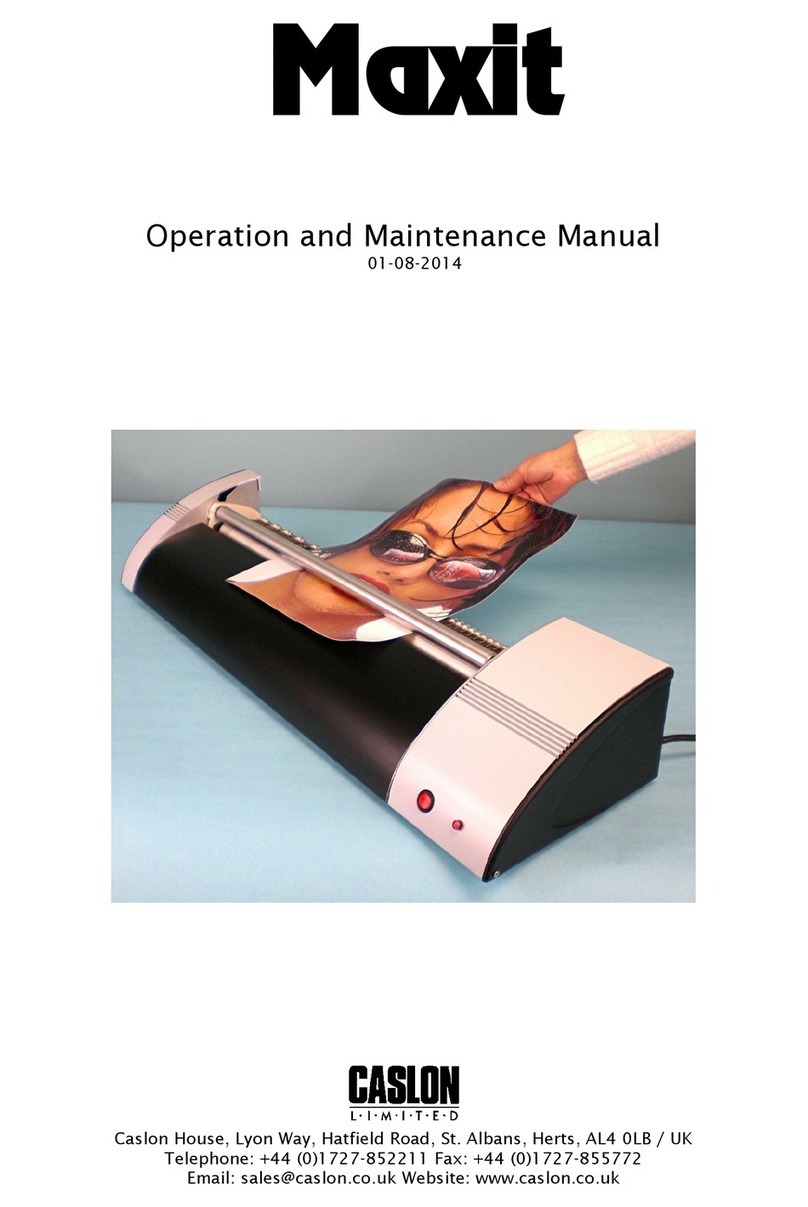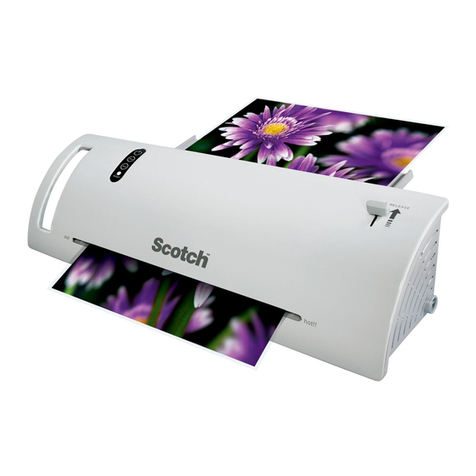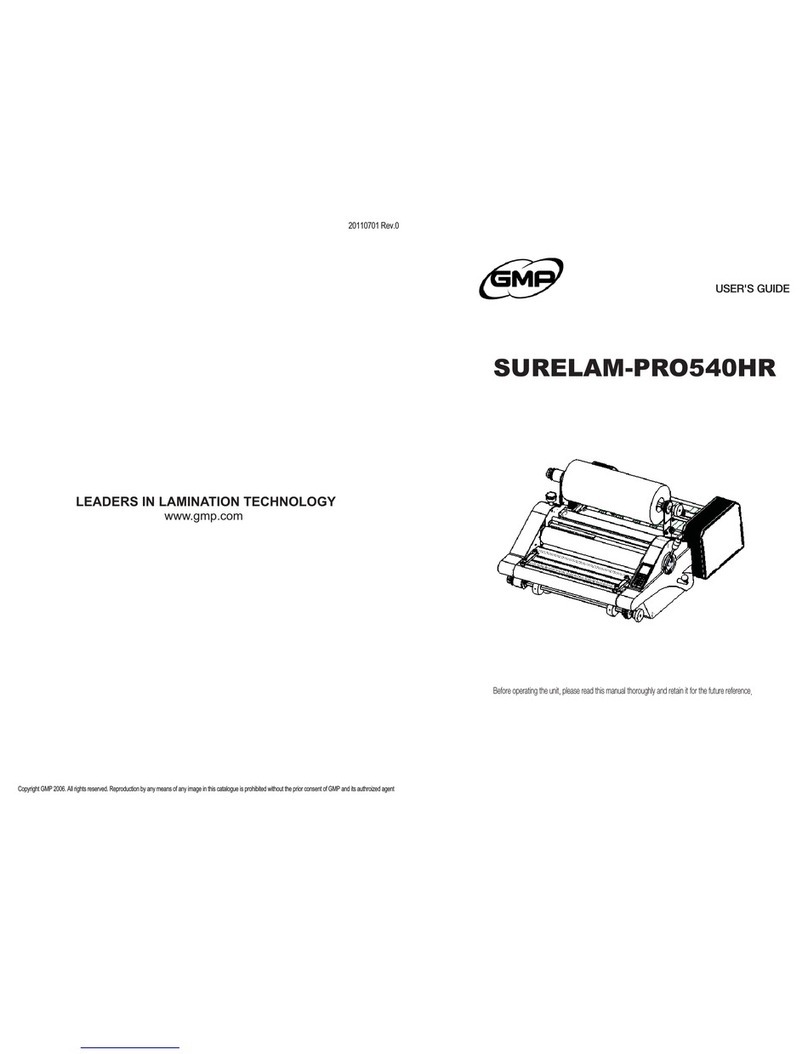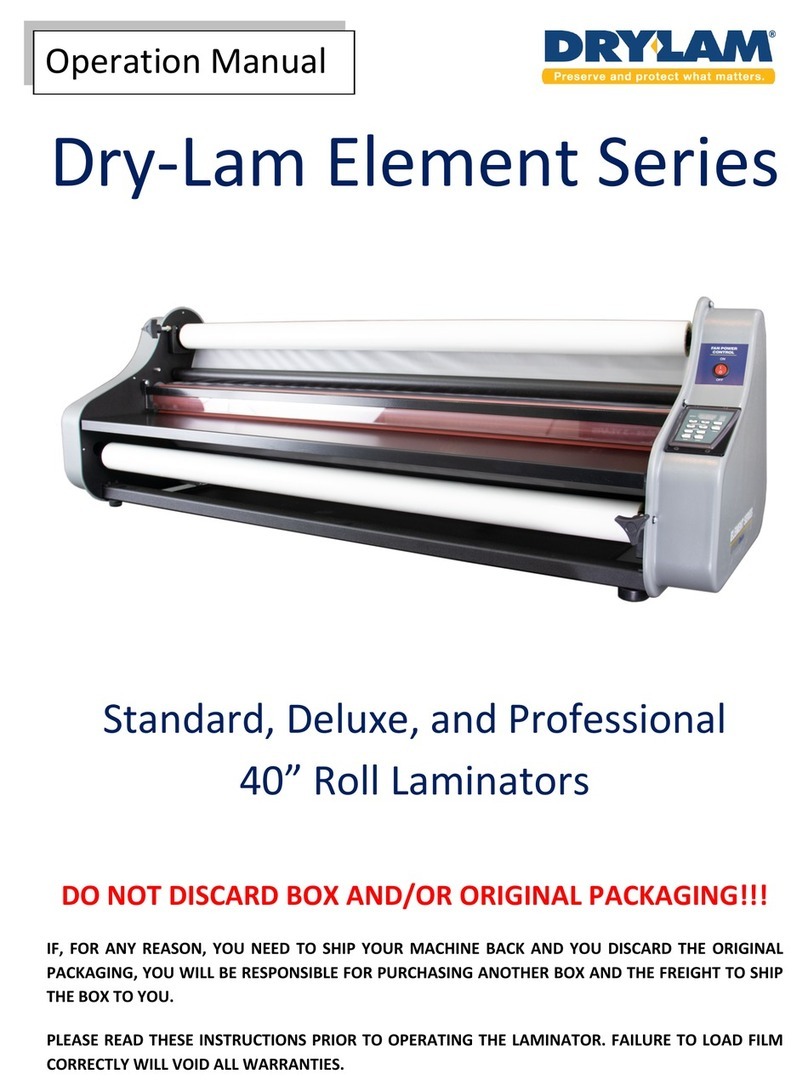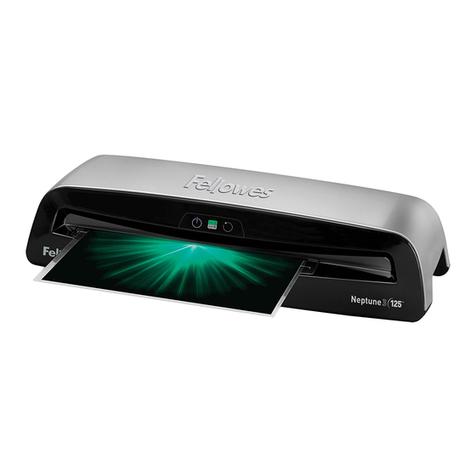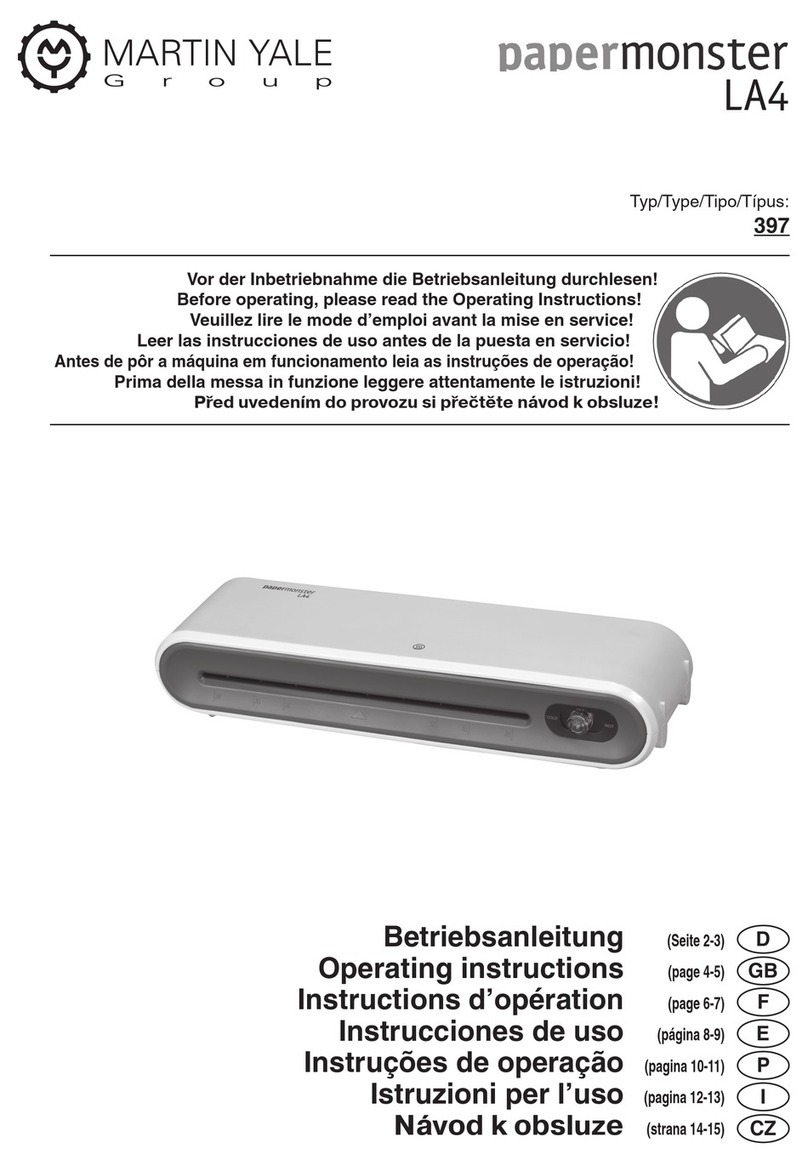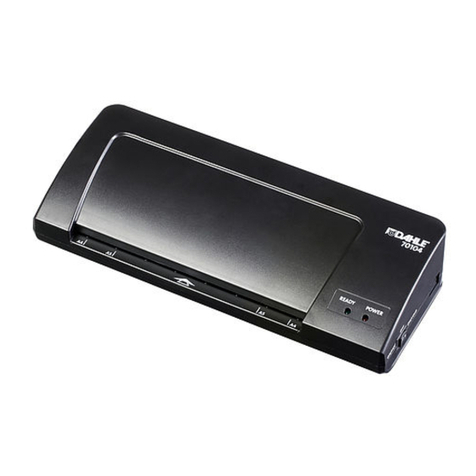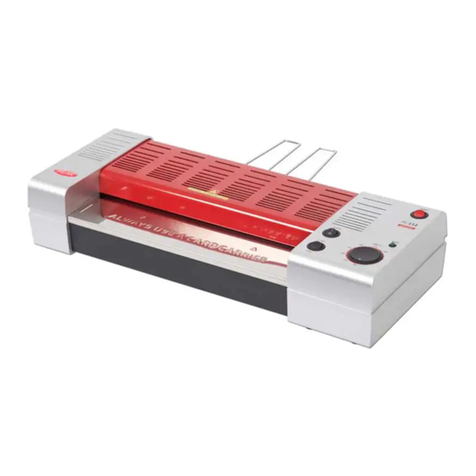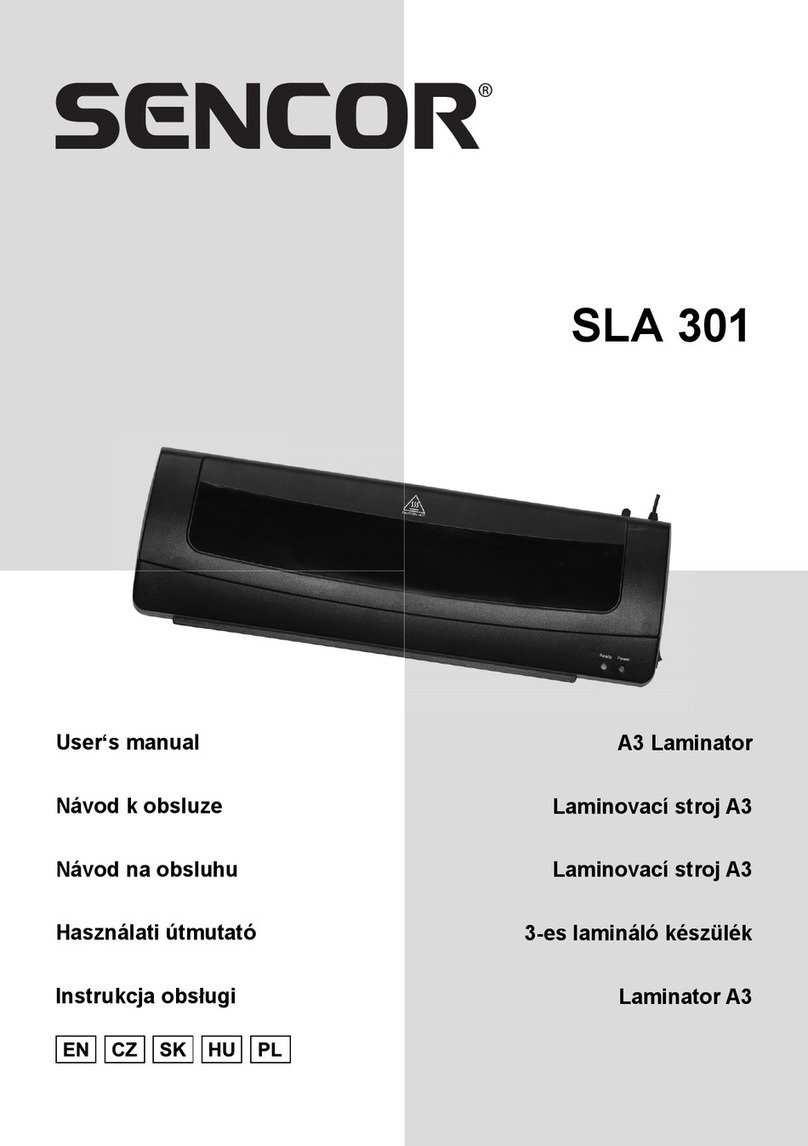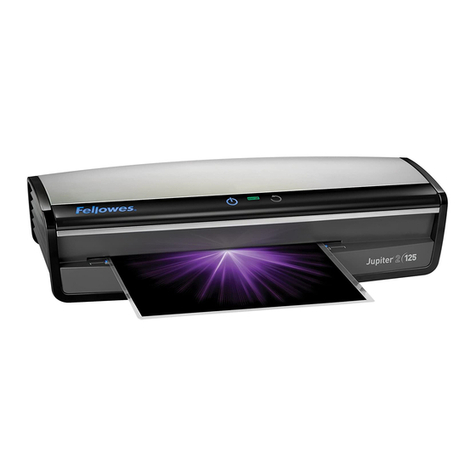Advanced Greig Laminators, Inc. AGL64R User manual

OPERATORS MANUAL
FOR
AGL64R
801 Burton Blvd. DeForest WI 53532
Ph: 608-846-7016 Fa : 608-846-1024
E-mail: info@aglaminators.com

Table of Contents
Table of Contents
Preface- General Descri tion
Cha ter 1 Installation
Selecting Area……………………………………………………………………………… 1-1
Uncrating……………………………………………………………………………………… 1-1
Leveling……………………………………………………………………………………… 1-1
Electrical Connection…………………………………………………………………………1-2
Pneumatic Connection……………………………………………………………………… 1-2
Recycling Packaging………………………………………………………………………… 1-2
Cha ter 2 Specifications
Machine Dimensions………………………………………………………………………… 2-1
Electrical Requirements…………………………………………………………………… 2-1
Pneumatic Requirements…………………………………………………………………… 2-1
Material Capacity…………………………………………………………………………… 2-1
Cha ter 3 Safety
General Machine Safety…………………………………………………………………… 3-1
Operator Safety……………………………………………………………………………… 3-1
Cha ter 4 Operation
General……………………………………………………………………………………… 4-1
Right Front Control Panel, Figure 1……………………………………………………… 4-2
Left Front Control Panel, Figure 2………………………………………………………… 4-3
Right Rear Control Panel, Figure 3…………………………………………………………4-3
Reset Panel, Figure 4 ………………………………………………………………………4-4
Temperature Controls……………………………………………………………………… 4-4
Laminator Setup………………………………………………………………………………4-5
Loading and Positioning Film……………………………………………………………… 4-5
Webbing the Laminator………………………………………………………………………4-5
Encapsulation Process…………………………………………………………………… 4-6
Pressure Sensitive Process……………………………………………………………… 4-7
Process Output Trouble Shooting……………………………………………………… 4-8
Process Control Chart……………………………………………………………………… 4-9
PLI Chart…………………………………………………………………………………… 4-11
Cha ter 5 Maintenance
Nip Roll Section……………………………………………………………………………… 5-1
Checking the Nip…………………………………………………………………………… 5-1
Zeroing the Nip……………………………………………………………………………… 5-1
Cleaning the Nip Rolls……………………………………………………………………… 5-1
Roller Open and Close Rate……………………………………………………………… 5-2
Lubrication…………………………………………………………………………………… 5-2
Electrical Schematic………………………………………………………………………… 5-3
Pneumatic Schematic……………………………………………………………………… 5-4
Cha ter 6 Warranty
Limited Warranty………………………………………………………………………………6-1

Preface-General Descri tion
i
Preface
Your Advanced Greig Laminators, Inc. (AGL) laminator is a finely engineered and designed piece of
equipment.
Standard equipment includes a 1/2 HP DC drive (variable and reversible), manually operated brake and
clutch, plus an air-operated laminating section with easily adjustable spacer system for controlled
laminating nip opening.
The nip rolls are the heart and soul of the laminator. To insure a quality end product, the rolls are rigid
enough to carry their weight, plus the working pressures against them without deflecting. The covering is
ground straight and concentric to the bearing journals to insure a constant uniform opening at the
laminating nip between the top and bottom roll. The power transmission from the drive motor to the
bottom laminating roll and the release liner windup clutch is with chain. The laminating nip section is
protected with an electric photo-cell and safety cable system.
The AGL design has a rigidly constructed steel frame. All parts are machined to prints, ensuring
complete interchangeability of all parts, manufactured or purchased. Adjustable air pressure to the
laminating nip section is supplied via your regulated, clean and dry air.

Installation
1-1
Selecting Area
Select an area that has a smooth, level surface for the laminator to set on, this will allow for easier
maneuverability of the machine if it requires moving later on. The area should be large enough to allow
an operator ample room to properly handle your largest product on the infeed and outfeed sides of the
laminator. The sides of the laminator should also be easily accessible in case service or maintenance is
required. AGL appro imates this area should be about 7-8 feet in front and back of the machine and 3-4
feet on either end. This is only a suggestion, your plant and the products to be laminated will be the
determining factor.
Uncrating
Your new laminator may come in a full crate. The crate is designed to be usable for future shipping if
required, so careful disassembly of the crate is important if the crate is to be reused. The crate is held
together by screws (phillips head) a power screwdriver with a phillips bit is recommended but not required
for uncrating. First, remove the top of the crate, keep the screws for future use on the crate. Ne t,
remove the front of the crate (it is recommended that two people disassemble the crate, so one person
can hold the panels while the other removes the screws). Move around the crate and remove the
remaining panels. Remove the bolts holding the laminator down to the skid. A fork truck can now lift the
laminator off the skid (it is possible to get the laminator out of the crate after removing only the top and
front and the hold down bolts). With the laminator on the fork truck, thread the adjusting bolts into the
lower cross bar, make sure that the bolt heads are about ½” above the caster. Lower the machine down
onto the casters. With 3-4 people to guide the machine, roll the machine into the final position.
The laminator is a large heavy piece of equipment. Do not attempt to
move the machine with one person. Injury is possible as well as
permanent damage to the laminator. The laminator should only be
rolled on a relatively smooth and level surface. Tipping or forcing the machine over large bumbs
can destroy the alignment of the rolls, idlers, and unwind/windup shafts. This alignment is
required for proper lamination. Advanced rieg Laminators, Inc.’s warranty does not cover
malfunction of the machine due to improper handling of the machine during installation.
Turn the leveling bolts down until they touch the floor. Remove the shrink wrap, bands, and protective
coverings from the rolls.
Do Not use a knife or other sharp object to remove the shrink wrap
from the laminator and the protective coverings from the rolls. This
can cause irreparable damage to the laminator enclosures and rolls.
Leveling
The laminator has been trammed and burned in at the factory, but to insure the alignment of the machine
it must be leveled in its final position. To level the machine, set a level on the upper front unwind/windup
shaft. Turn the front leveling bolts until the bubble shows that the shaft is level. Repeat this procedure on
the upper rear unwind/windup shaft. Ne t place the level across the upper unwind/windup shafts (front to
rear) and adjust the leveling bolts to achieve a level reading. Repeat this procedure on the other end of
the machine. Be sure to check the left to right level as it may have shifted when leveling from front to
back. Repeat the previous procedures until you have a level reading at all four places. Tighten the jam
nuts on the leveling bolts up tight against the lower cross bar to lock the bolts in place.
Do Not lift the casters more than ½” off the floor. This will cause the
machine to be unstable.

Installation
1-2
Electrical Connection
Refer to the Electrical Requirements under Specifications for the proper requirements for your
laminator. All connections to components and terminal blocks should be checked for tightness before
initial startup. This will help avoid and electrical problems caused by connections that may have loosened
due to vibration during shipping. A readily accessible disconnect device shall be incorporated into the
fi ed wiring circuit. The switch on the laminator is not considered a disconnect device. Consult a
qualified, licensed electrician to ensure that the power supply for the machine is properly installed in your
facility. Qualified personnel can remove the RH enclosure cover to allow access to the terminal strip and
grounding lug. Advanced Grieg Laminators, Inc. will not be responsible for damage caused by incorrect
electrical installation.
Pneumatic Connection
Refer to the Pneumatic Requirements under Specifications for the proper requirements for your laminator.
The air supply should be clean, dry, and regulated. Failure to properly clean and dry the air supplied to
the laminator will cause damage to the cylinders. The laminator is supplied with a 1/4npt port for your
final connection.
The air supply to the laminator must be clean and dry. Particles and
moisture can damage the cylinders.
Recycling Packaging
If your machine came in a fully enclosed crate, the crate can be stored flat for future use or dismantled
and the wood can be recycled. The screws can be kept for future use of the crates or stored for some
other use. The shrink wrap is not recyclable and should be thrown away. The foam protective coverings
over the rolls can be recycled to be used for other shipping purposes.

S ecifications
2-1
Machine Dimensions
Length: 88”
Height: 60”
Depth: 38”
Weight: 2100 lbs.
Electrical Requirements
220/230 VAC single phase, 50/60 Hz, 60 Amp service.
Pneumatic Requirements
Appro imately 2-3 cfm at 60-90 psi line pressure supplied via your cleaned/dried/regulated plant air.
Material Ca acity
Upper Front Station: 10” Diameter 60 long 3” Diameter core.
Lower Front Station: 10” Diameter 60 long 3” Diameter core. (Thermal)
10” Diameter 61 long 3” Diameter core. (Pressure Sensitive)
Upper Rear Station: 10” Diameter 60 long 3” Diameter core. (Thermal)
10” Diameter 61 long 3” Diameter core. (Pressure Sensitive)
Lower Rear Station: 10” Diameter 60 long 3” Diameter core.
Middle Front Station: 8” Diameter 60 long 3” Diameter core. (Thermal)
8” Diameter 61 long 3” Diameter core. (Pressure Sensitive)
These are physical dimension restrictions. The weight of the supply roll should never e ceed 90 lbs.

Safety
3-1
IMPORTANT
READ THIS SECTION BEFORE OPERATIN YOUR LAMINATOR
General Machine Safety
The following messages are written here for your safety, all operators and others around the laminator
should read, understand and follow these messages.
1. Read and understand all the safety instructions.
2. Keep this manual in a place where it can be easily referenced by all operators.
3. All connections to com onents and terminal blocks should be checked for tightness before
initial startu . This will hel avoid and electrical roblems caused by connections that may
have loosened due to vibration during shi ing.
4. Use only the recommended power source to run the laminator. Consult a qualified and licensed
electrician if you are unsure of the power supply and the safety features of the supply.
5. If power supply cord is run across the floor, provide adequate protection to the cord to avoid damage
from foot traffic, dropped items or rolling items.
6. Do not attempt to service the laminator without qualified personnel available. Damage to the machine
or injury to you could be caused by moving parts or high voltage.
7. Do not operate the laminator with out all guards in place. If a guard is damaged or not working
properly, replace or repair before returning the machine to operation. If the machine is run without all
guards in place the safety obligation of the manufacturer is null and void.
8. Do not insert fingers, hands, or items into openings in the sideframes. Items may become entangled
in moving parts or in contact with high voltage.
9. Disconnect or lockout power from machine when any service is required and when cleaning the nip
rolls.
10. Disconnect or lockout power from the machine and refer to service personnel if the performance of
the machine changes indicating a problem or if machine does not operate normally to correct
operational procedures.
O erator Safety
Your laminator is designed to protect the operator from injury when used properly. Do not operate the
machine without all guards and protection devices in place, serious injury could occur.
The nip section can pull you into laminator! Do not place fingers
into the nip section when the rolls are rotating. It is recommended
that operators tie long hair back and not wear neckties, loose
clothing and jewelry since they can be caught in the nip section and
pull the operator into the machine. Proper equipment such as
gloves should be used if the material being laminated requires it.
The nip rolls will lower if there is a loss of air pressure.
The nip section is protected by a photoelectric eye that shoots a light beam across the machine in front of
the nip rolls. When the machine is in continuous run mode, the rolls will stop when the beam is broken by
an item too close to the nip section. However, if the machine is in jog mode, an alarm will sound warning
the operator that he/she is very close to the nip section, but the rolls will not stop rotating. The jog mode
is useful for starting prints into the laminator and smoothing the print corners out as they enter the nip
section, but this mode should be used as sparingly as possible since it puts the operator at a greater risk
than the run mode.
When the machine is in jog mode, an alarm will sound to warn the
operator but the rolls will not stop rotating when the light beam is
broken. Use this mode sparingly and with respect.
There are E-stop switches on all four corners of the machine, as well as an E-stop ribbon switch in front
and rear. The machine will stop and the nip section will open if any of these switches are tripped.
Striking the red mushroom heads on the switches with your palm can activate the four switches. The
ribbon switch can be tripped by using your foot and stepping on the yellow ribbon. The machine must be
reset after and E-stop condition has occurred. Refer to the O eration section for further details.

O eration
4-1
General
1. Power: A switch in the lower right rear switches the main power on and off. The switch is labeled
clearly so the operator can tell if the power is on or off.
2. Reset: A reset button is used to start the machine initially and restart the machine after an E-stop
condition has occurred. After the power is turned on, the reset button is held for 15 seconds to allow
the machines electrical controls to reset to initial settings.
3. Speed: A potentiometer is used to control the speed that the laminator will run product through. Your
laminator has the electrical and mechanical capability to run up to 20 feet per minute, but the quality
of the product output is the governing factor in ma imum process speed.
4. E-stops: E-stop switches are located at all four corners to allow the operator to stop the machine and
open the nip rolls and pull rolls in case of emergency. The button must be pulled back out before
pressing the reset button to restart the machine.
5. Nip Rolls: The nip rolls are the heart and soul of the laminator and must be cared for properly in
order to give years of quality product output. Always dial the shim wheel to a shim setting greater
than “0” when the machine is not in use. This will prevent the rolls from forming a flat spot from
resting against each other. This also applies to the pull rolls.
Always set the shim wheel to a setting greater than “0” when the
machine is not in use. This will prevent the roll from coming together
and forming a flat spot. Permanent damage can be caused to the rolls
if this warning is not heeded.
6. Fwd-Rev: This button is a lighted button that will determine which direction the machine will run. If
the button is not lit, the machine will run from front to back. If the button is lit, the machine will run
from back to front.
7. Stop: This button will stop the rotation of the nip rolls.
8. Run: This button will allow the machine to run continuously in the direction depicted by the Fwd/Rev
button and at the speed set by the potentiometer.
9. Foot Switch: The foot switch will run the laminator in the direction depicted by the Fwd/Rev button
and at the speed set by the potentiometer. The foot switch is always active, this allows an operator to
press the foot switch to get a print started and then press the Run button to transfer to the continuous
run mode without stopping.
10. Temperature Control with switch: The two position switch allows the operator to turn the heater in the
roll on or off. The temperature controller allows the operator to set a desired temperature for a
process.
11. Brakes: Turn the knob clockwise to increase web tension from the unwind station. Turn the knob
counter clockwise to decrease web tension from the unwind station.
12. Clutches: Turn the knurled knob towards you to increase the web tension to the windup station. Turn
the knurled knob away from you to decrease web tension to the windup station.
13. Pull Roll Clutch: Turn the regulator clockwise to increase the pressure to the pull roll clutch and
counter clockwise to decrease pressure to the clutch.

O eration
4-2
Right Front Control Panel
The right Front control panel looks like the figure below.
To Roller Controls:
Two position switch opens and closes the nip rolls. The
regulator adjusts the air pressure to the cylinders that
create the pressure on the nip rolls. The gauge indicates
air pressure which allows for repeatable results.
Drive Motor Controls:
RUN button switches the laminator from jog mode to run
mode.
S eed Pot sets the laminators speed. 0-20 FPM
STOP button stops the drive from turning thus stopping
the rolls.
FWD REV switch selects the direction the machine will
run.
E-Sto switch will stop the laminator and open the rolls.
Figure 1 Right Front Control Panel

O eration
4-3
Left Front Control Panel
The left front control panel looks like the figure below.
U er Roll Heat Control:
Two position switch turns heater for upper roll on and off.
The temperature controller allows the operator to set a
desired temperature for the process. The controller will
maintain that temperature during the process.
Lower Roll Heat Control:
Two position switch turns heater for upper roll on and off.
The temperature controller allows the operator to set a
desired temperature for the process. The controller will
maintain that temperature during the process.
Web Cooling Fans:
Two position switch turns the motorized impellers that
create a cool air flow to the web on and off.
Emergency Sto :
E-Stop switch will stop the laminator and open the rolls.
Figure 2. Left Front Control Panel

O eration
4-4
Right Rear Control Panel
The right rear control panel looks like the figure below.
To Pull Roller Control:
Two position switch opens and closes the pull rolls.
The regulator adjusts the air pressure to the cylinders
and clutch. The gauge indicates air pressure which
allows for repeatable results.
Drive Motor Controls:
RUN button switches the laminator from jog mode to
run mode.
S eed Pot sets the laminators speed. 0-20 FPM
STOP button stops the drive from turning thus
stopping the rolls.
FWD REV switch selects the direction the machine
will run.
Emergency Sto :
E-Stop switch will stop the laminator and open the
rolls.
Figure 3. Right Rear Control Panel

O eration
4-5
Reset Panel
The reset panel looks like the figure below.
Reset Switch
The momentary pushbutton switch must be
pressed and held for 15 seconds after turning
on main power and after and emergency stop.
Figure 4. Reset Panel
Tem erature Controls
Your laminator has heated rolls that allow you to laminate with thermal films and pressure sensitive films
that require heat to activate the adhesive. The temperature controls have a ma imum temperature set at
the factory. The operator cannot set the temperature above this point. The controllers are also set up
with an over temp alarm. If there is a failure and the heater coils heat out of control, the temperature
controller will create an e-stop condition.
The temperature controller looks like the graphic shown at the left. The
operator only needs to press and hold the asterisk key then press the up
arrow key to raise the “Set Point Temperature” or the down arrow to lower the
“Set Point Temperature”. The square green LED in the upper left will stay on
initially as heater comes up to temperature and flash as the controller pulses
electricity to maintain the heat in the rolls. The top alarm LED will flash on if
the rolls e ceed the upper temperature limit set at the factory and then the
machine will go into an E-stop condition. The rolls must be allowed to cool
down before restarting machine. The machine can be restarted by pressing
and holding the Reset button for 15 seconds. If the machine fails again in the
same manner, the laminator should be serviced by qualified personnel.

O eration
4-6
Laminator Setu
Your laminator has been designed to make the setup and lamination process as easy and repeatable as
possible, however, there will be techniques that make this phase easier that you will only learn by using
the machine. Do not get frustrated if the setup process takes longer than you e pected, the process will
get quicker and easier the more you use your laminator.
The set up process is comprised of the following steps:
1. Loading and positioning the film.
2. Webbing the laminator.
3. Setting the process controls to initial settings.
4. Warm up time (if required by process)
Loading and Positioning the Film
1. Determine the way the film is wound, adhesive inside or outside. This will determine the way it is
placed on the unwind shaft. If the adhesive is wound to the inside, the web will be pulled from the
bottom of the supply roll. The web path configuration figures show the film in this configuration.
2. Swing the upper rear shaft out for loading. The lower and center front unwind stations require
you to loosen the upper clamp blocks to allow the shaft swing out.
3. Remove the locking core chuck and the core idler. The locking core chuck has rollers that rotate
out to hold the core as it turns. Slide the locking core chuck, film roll, and core idler onto the shaft.
4. Rotate the shafts back into place, tighten the upper clamp blocks back onto shaft on the lower
and center front unwind stations.
5. Measuring from the sideplates, make sure the film is centered on the shaft. Once the
measurements from each end of film to the sideplates are equal, tighten the locking core chuck
and core idler down.
6. Repeat this process on any other unwind station.
7. If the film is a pressure sensitive with a release liner, you will need to set up a wind up station.
This is done by webbing the film under an idler and separating the film and liner. Once the liner
has been separated from the film, it must be routed up over the second idler and taped to a
windup core.
8. The wind up core is a cardboard core that is held between the sideframes by a spring loaded
disc. To remove the core, pull the core to your right until it clears the driving end and swing core
out. Keep in mind that the windup cores will rotate the e act same direction as the lower nip roll.
9. Tape the release liner to the core and windup any slack by hand. Feed the film with adhesive
around and through the nip opening. Note: You may require feeder stock to kee the film
from sticking to the lower ni roll.
Webbing the Laminator
The term webbing means routing the film through the laminators’ idlers and nip rolls and thus creating
a web. The easiest way to web the machine up after loading the film is by using a piece of feeder
stock. The stock can be anything that is relatively stiff, but still fle ible enough to route around the nip
roll. A common e ample would be tag board.
The first step in webbing the machine is to have a planned web path configuration. There are two
web path configurations shown for two different processes in this manual. The encapsulation process
uses thermal film from top and bottom to “encapsulate” the substrate being fed into the laminator.
This process seals the edges and protects the substrate. Refer to figure 3 as the webbing process is
described below.

O eration
4-7
Enca sulation Process
1. Load thermal film on the upper rear and center front unwind stations. Loosen the brake tension
by rotating the knob counter clockwise.
2. Set the shim wheels to “0”, place a piece of feeder stock into the nip rolls with plenty of stock
hanging out the front. Close the nip rolls onto the piece of feeder stock.
The nip section can pull you into laminator! Do not place fingers
into the nip section when the rolls are rotating. It is recommended
that operators tie long hair back and not wear neckties, loose clothing and jewelry since they
can be caught in the nip section and pull the operator into the machine
3. Pull the film from the upper rear station down under the idler roller directly behind the nip roll and
over the top of the top nip roll. Tape the film to the feeder stock.
4. Remove the infeed table for easier access to the front center station. Pull the film from the center
front station up over the idler roller directly behind the bottom nip roll and under the bottom nip
roll. Tape the film to the feeder stock.
5. Replace the infeed table.
6. Set the speed potentiometer to a low setting, select Fwd and press Run. Move to the rear of the
machine.
7. Open the pull roll guard until it latches, open the pull rolls using the handle on your right hand
side. Guide the stock coming from the nip rolls over the center idler and down through the pull
rolls. Close the pull rolls after the film has passed through the rolls. Close the pull roll guard.
8. To wind up the product, route the film down to the lower rear windup and tape to the core.
9. Turn the heater controls to “On” and set the desired temperature. While the rolls are heating up
use your process control chart to make all initial settings on the brakes, speed and nip pressure.
10. With rolls at the desired temperature you may feed the substrate into the nip section.
11. If your substrate is in roll form, you may use the lower front unwind station to feed it into the nip.
Route the substrate from the unwind station around the infeed table roller and into the nip. Figure
3 shows the front lower station being used as the unwind and the lower rear being used as the
product windup. Follow the procedure to load the film as discussed in the Loading Film section.
Roll Fed Enca sulation Process Sheet Fed Enca sulation Process
Figure 5. Enca sulation Process

O eration
4-8
Pressure Sensitive Process
1. Load film on the rear upper unwind station. Loosen the brake tension by turning counter knob
counter clockwise.
2. Set the shim wheels to “0”, or to the correct shim height if a board is being used. Place a piece of
feeder stock into the nip rolls with plenty of stock hanging out the front and close the nip rolls onto
the piece of feeder stock.
The nip section can pull you into laminator! Do not place fingers
into the nip section when the rolls are rotating. It is
recommended that operators tie long hair back and not wear
neckties, loose clothing and jewelry since they can be caught in the nip section and pull the
operator into the machine
3. Pull the film from the upper rear station down under the idler roller directly behind the nip roll and
over the top of the top nip roll. Separate the release liner from the film and tape the film to the
feeder stock.
4. Route the release liner in an “S” wrap on the idler rolls and back to the upper front windup station.
Tape the release liner to the wind up core.
5. Set the speed potentiometer to a low setting, select Fwd with the selector switch. Jog the
machine forward to run out film. Be sure to place scrap substrate between the film and the lower
nip roll to avoid adhesion to the lower roll.
6. Move to rear of machine and guide film up over the pull roll guard.
7. Turn the heater control to “On” and set the desired temperature.(if required) While the roll is
heating up, use your process control chart to make all initial settings on the brakes, speed and nip
pressure.
8. With roll at the desired temperature you may feed the substrate into the nip section.
9. If your substrate is in roll form, you may use the lower front unwind station to feed it into the nip.
Route the substrate from the unwind station around the infeed table roller and into the nip. Figure
4 shows web path for this process. Follow the procedure to load the film as discussed in the
Loading Film section.
Front to Back Pressure Sensitive Back to Front Pressure Sensitive
Figure 6. Pressure Sensitive Process

O eration
4-9
Process Out ut Trouble Shooting
Straight waves in out ut
Pull roll creating too much tension Decrease clutch air pressure
Film not cooling fast enough Slow feed rate down and turn on cooling system.
Waves on one side of out ut
Nip “zero” setting may be incorrect Check nip setting and adjust if necessary.
Refer to Zeroing the Ni in the maintenance section.
Pull roll “zero” setting may be incorrect Check nip setting and adjust if
necessary. Refer to Zeroing the Ni in the maintenance section. Pay particular
attention to sides opposite the waves.
D-Waves in Product
If waves are in the substrate and not film
Substrate problem Check the substrate moisture content and the substrate
tension.
If waves are in the film
Low tension between nip & pull roll Increase air pressure to pull roll clutch.
Roll pressure settings Adjust nip and pull roll settings as required.
Web Breaks
Web breaks caused by e cess tension: If the web breaks between the unwind station and the
nip, reduce the unwind brake tension. If the web breaks between the laminating opening and the
rewind station, reduce the rewind clutch tension.
Web breaks will occur from faulty material. The AGL laminator will not correct this; the material
must be replaced.
Curl in Product
1. Running a hot mount material in cold-mount machine sometimes creates a curl in the finished
product.
2. Too much web tension: Reduce unwind brake tension.
3. E cessive roll pressure: Reduce upper roll pressure.
4. Wrong spacers being used.

O eration
4-10
Wrinkles in Product
1. Check the adhesive stock for wrinkles while operating. If wrinkles e ist, this is a
manufacturing material defect, and must be cut out of the roll. A laminator will not correct
material defects.
2. String the web straight and square between the unwind and the windup shafts. If it is not
straight and square, the tension will not be even across the web and will cause wrinkling.
3. If the web is loose between the unwind and the drive roll, there is not enough tension on the
unwind brake. Increase the tension on the unwind brake to correct.
4. If the web is loose between the windup and the drive roll, there is not enough tension on the
windup clutch. Increase the tension on the windup clutch to correct.
5. If the web gets narrow between the unwind and the drive roll, there is too much tension on
the unwind brake. Decrease the tension on the unwind brake to correct.
6. Top and bottom laminating rolls may not be parallel. Make sure spacer shims are the same
size, then zero the nip. Refer to Zeroing the Ni in the maintenance section.
Poor Lamination
1. All substrate materials must be cleaned and free of dust, dirt, grease, and any other type film.
2. Poor lamination is usually caused by thickness variation in the substrate materials such as
plywood, hard board or other such non-precisely made materials. To overcome this, cylinder
spacers may have to be removed and materials laminated without the use of cylinder
spacers, or the ne t smaller spacer may be used or special spacer utilized.
3. Materials such as Ple iglas or glass sometimes carry a greasy or oily film. These materials
may need to be cleaned with a solvent prior to lamination.
4. Poor lamination can be caused by defective material. To correct this, replace defective
material with higher quality material.
Bubbles in Product
1. Visually inspect materials, mounting or overlays for any voids in the adhesive film. If any
e ist, it cannot be corrected by any laminating machine - that part of the material should be
discarded.
2. Low pressure on nip rolls Increase air pressure to nip rolls.
3. Incorrect shim setting Adjust shim wheel to correct setting.
4. Nip “zero” setting may be incorrect Check nip setting and adjust if necessary. Refer to
Zeroing the Ni in the maintenance section.
Process Control Charts
In order to consistently output high quality product, the operator must have a definite starting point on the
many process variables. This can be achieved by having the operators document system settings when
you have achieved acceptable quality output. The process control chart will allow any operator to set the
machine up for a given process. Keep in mind that the system variables may require adjusting as the
process is being run, but the chart gives an e cellent starting point. Factors such as temperature,
humidity, changing film roll diameters all affect the process, therefore, operator technique in running the
machine is inevitable. There is a blank process control chart located on page 4-10, copy this page as
often as needed for new processes.

O eration
4-11
PROCESS CONTROL CHART
Process:
Product:
Material Top:
Material Bottom:
Other Material:
Date Settings Documented:
Front Control Settings
Speed (Ft/min): Direction: Forward Reverse
Nip Roll: Up Down Shim Dial Setting:
Roll Pressure: (PSI) Top Temp. Setting: Deg. F
Top Roll Heater: On Off Bottom Temp. Setting: Deg. F
Bottom Roll Heater On Off
Rear Control Settings
Pull Roll Clutch: On Off Pull Roll: Up Down
Pull Roll Clutch Setting:(PSI) Pull Roll Pressure:(PSI)
Shim Dial Setting:
Other Instructions:

O eration
4-12

Maintenance
5-1
Maintenance
As a result of years of e perience, refined engineering and construction techniques, very little time need
be lost to maintenance. However, regular maintenance will keep your laminator operating at its optimum
level.
Removing the enclosure covers to work on machine exposes person
to electrocution and moving parts hazard. Only trained service
personnel should perform maintenance with any guards or covers
removed.
Ni Roll Section
The most critical adjustment of the nip and pull rolls is the “zero” position. This adjustment makes the top
roll parallel to the bottom roll which creates even pressure and pull distribution across the face of the roll.
If the rolls are out of adjustment, the machine will not laminate properly. Zeroing the nip is done at the
factory before shipment, but should be checked at startup and if laminator is not creating quality output.
Checking the Ni
1. Place two pieces of thin paper (appro imately 1.0” wide by 12.0” long) between the upper
pressure roll and the lower roll (about 3.0” from each end).
2. Set the shim dial to the “0” setting and put the upper pressure roll in the down position by
activating pressure roll valve.
3. Pull gently on both pieces of paper, if both pieces of paper have the same drag, the nip is
fine, if the drag is different, follow the procedure below to correct the setting. The pull rolls
are adjusted the same as the nip rolls.
Zeroing the Ni & Pull Rolls
1. Loosen the sets screw in the cylinder stop.
2. Adjust the cylinder stop clockwise to raise the roll and counter clockwise to lower the roll.
3. Check the nip using the 3 steps shown in the Checking the Ni section.
4. Once the drag on the pieces of paper has been equalized, tighten the setscrew in the cylinder
stop.
Cleaning the Ni Rolls & Pull Rolls
Cleaning the nip rolls may require the nip rolls to be rotating. Rotate
the rolls at a very slow rate to avoid being pulled into the nip section.
Do not wear neck ties, loose clothing or hanging jewelry that could
be pulled into the nip section.
The nip rolls should be cleaned as often as necessary, the frequency will vary on the products used and
the processes being run. AGL recommends a mild detergent solution or denatured alcohol with a 100%
lint free cloth to clean the rolls. Your film manufacturer can recommend solvents that will remove the
adhesive from silicone and neoprene rolls without causing damage to the coverings. To facilitate the
cleanup process, adhesives should be cleaned from the rolls as soon as possible and while the roll is still
warm. A rubber "eraser" has been included in your accessory kit that can be used to clean the adhesive
from the warm rolls. Rub the eraser over the adhesive with the rolls turning very slowly. The cloth and
alcohol can be used to remove the residue.
Use of incorrect solvents on your nip and pull rolls can cause
irreparable damage to the coverings. Advanced rieg Laminators,Inc.
is not responsible for damage to roll coverings caused by these
solvents.
Table of contents
Other Advanced Greig Laminators, Inc. Laminator manuals
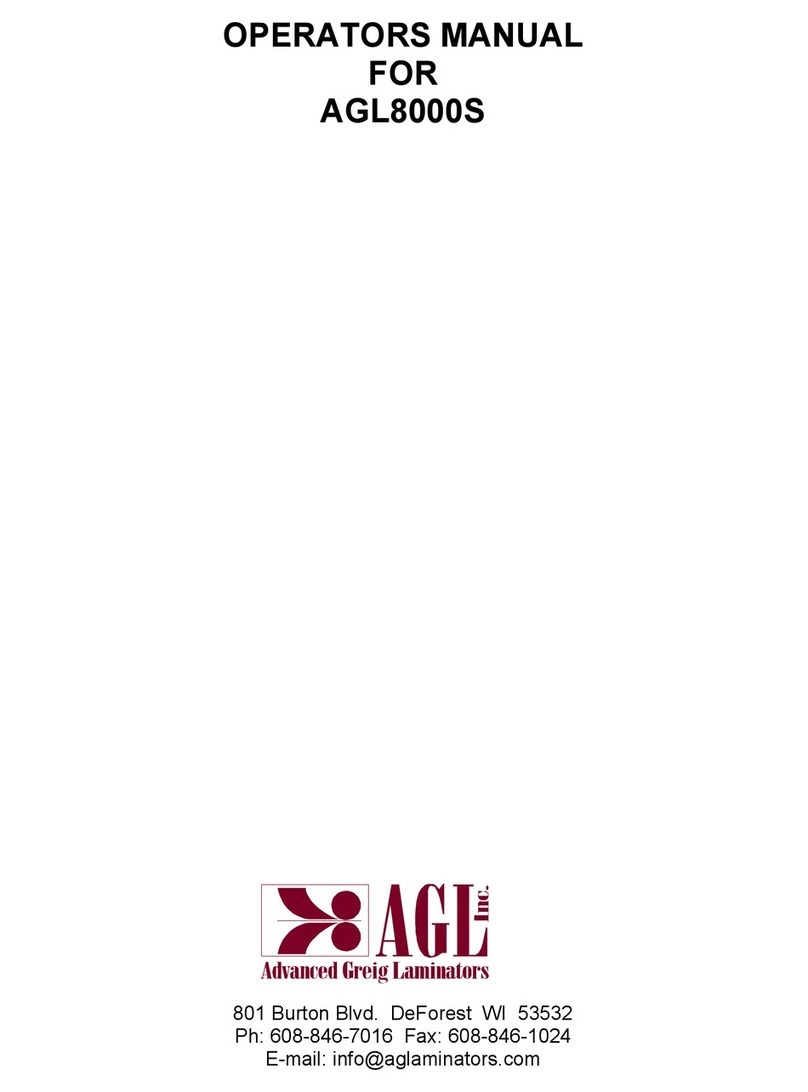
Advanced Greig Laminators, Inc.
Advanced Greig Laminators, Inc. AGL8000S User manual
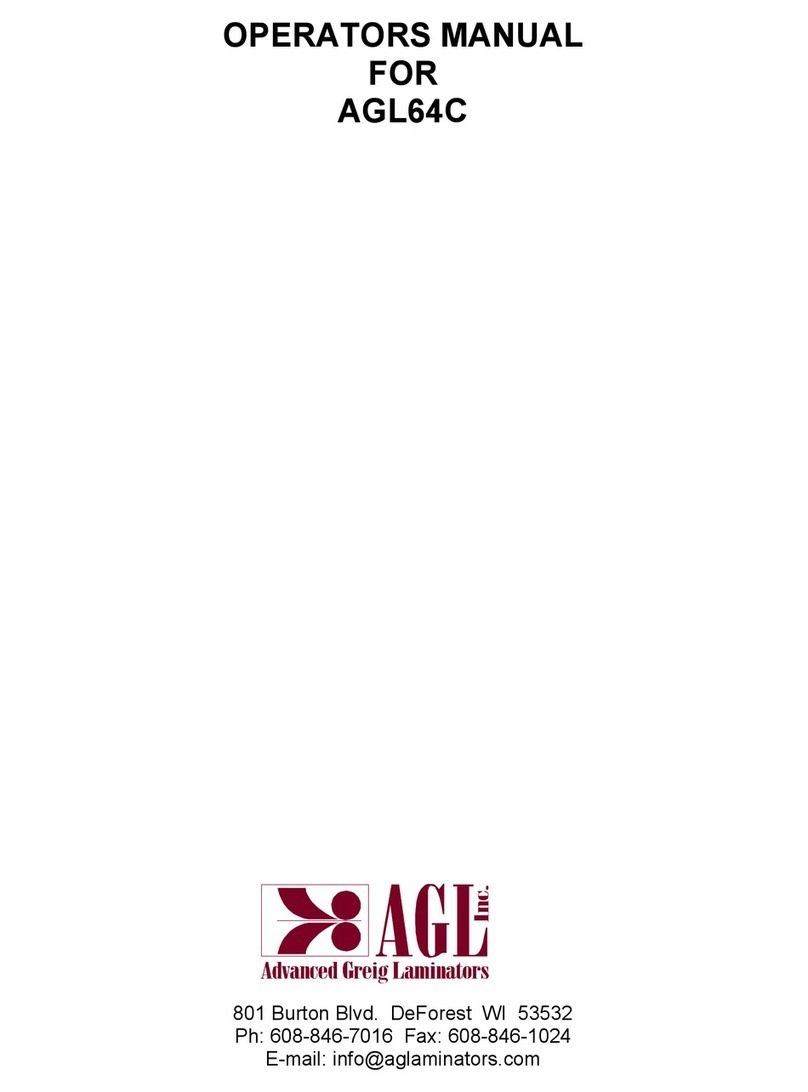
Advanced Greig Laminators, Inc.
Advanced Greig Laminators, Inc. AGL64C User manual
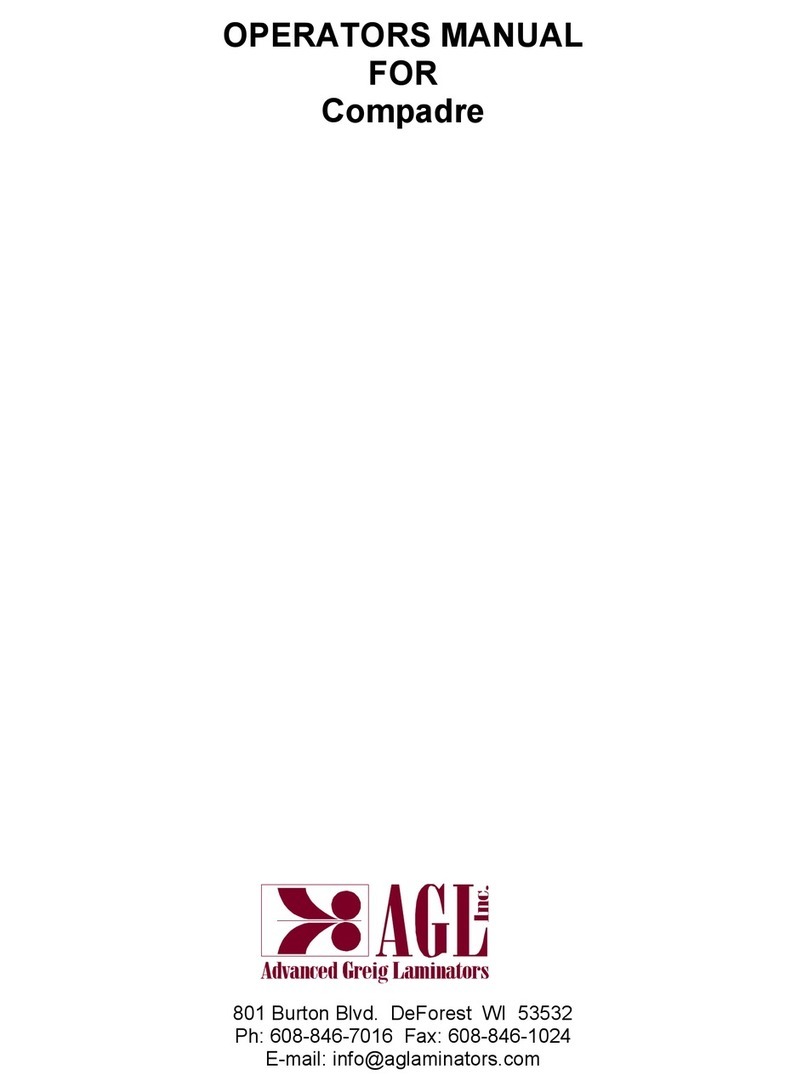
Advanced Greig Laminators, Inc.
Advanced Greig Laminators, Inc. Compadre User manual
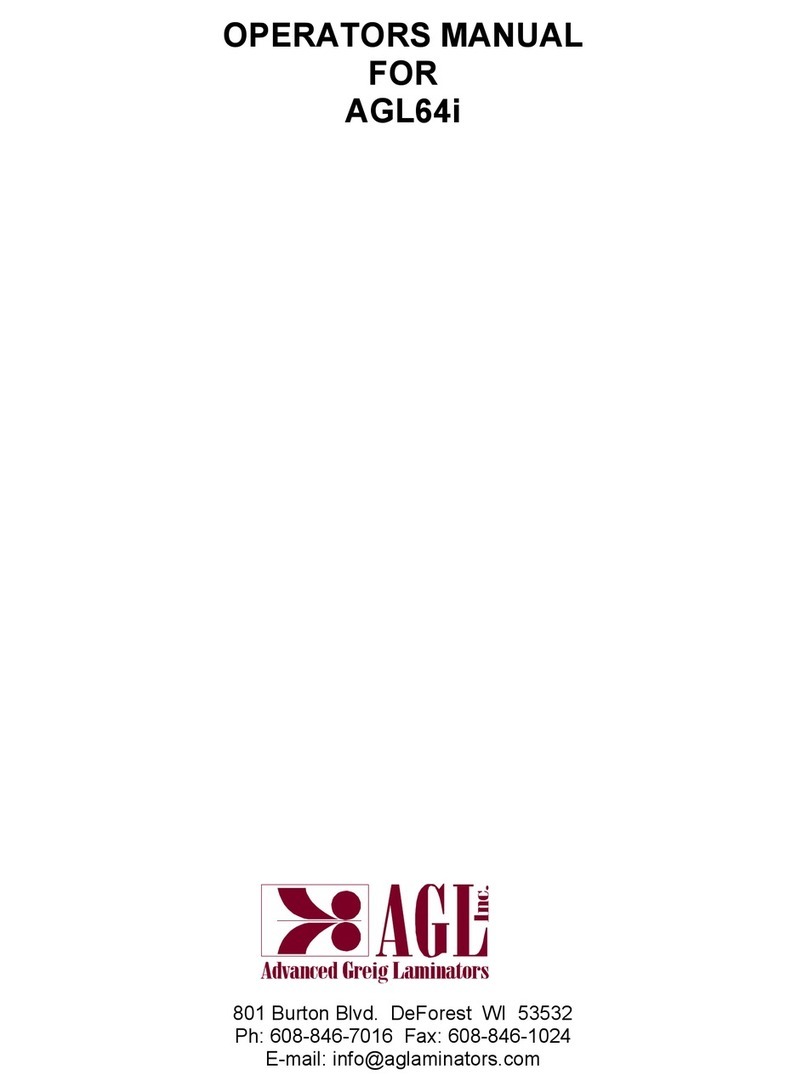
Advanced Greig Laminators, Inc.
Advanced Greig Laminators, Inc. AGL64i User manual
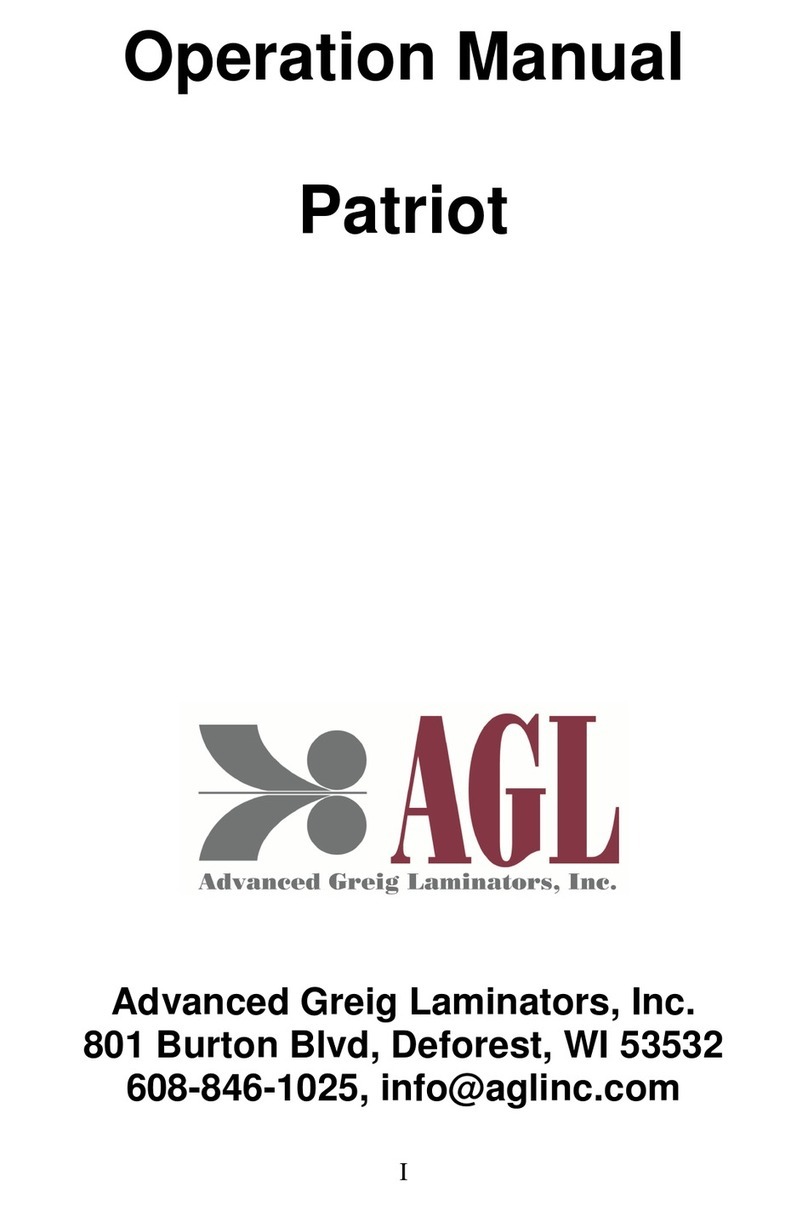
Advanced Greig Laminators, Inc.
Advanced Greig Laminators, Inc. Patriot User manual
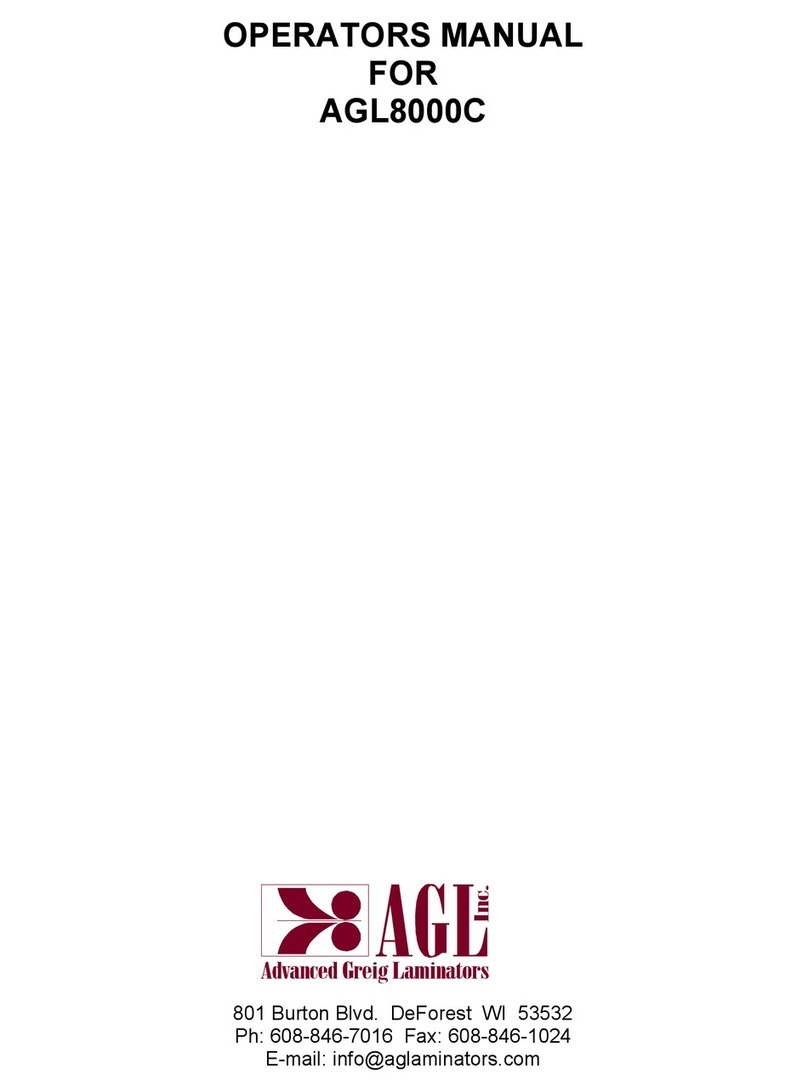
Advanced Greig Laminators, Inc.
Advanced Greig Laminators, Inc. AGL8000C User manual
